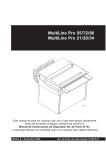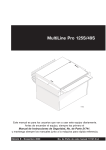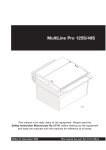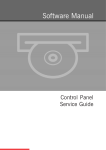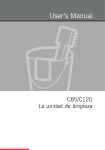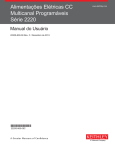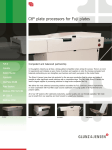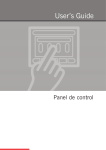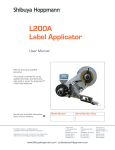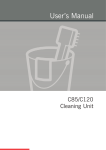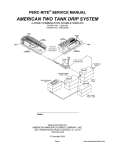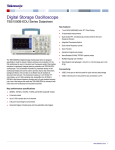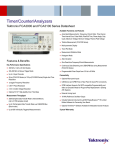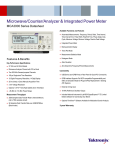Download 3 - Glunz & Jensen
Transcript
FILM PROCESSORS
USER MANUAL
MultiLine Pro 55/72/86
MultiLine Pro 21/28/34
MultiLine Pro 55/72/86
MultiLine Pro 21/28/34
T1747
This manual is for daily users of the equipment. Always read the
Safety Instruction Manual part No 21741 before starting up the equipment
and keep the manuals with the machine for reference at all times.
Edition B, November 2000
This manual has part No 51135-GB-A
550, 720, 860
55/21, 72/28, 86/34
- GB -
FILM PROCESSOR
GENERAL INFORMATION
This manual is published by:
Glunz & Jensen A/S
13 - 15 Haslevvej, DK - 4100 Ringsted, Denmark
Phone:
+45 5768-8181
Fax:
+45 5768-8340
Glunz & Jensen Inc.
21405 Airpark Drive, P.O. Box 97, Elkwood, Virginia 22718, USA
Phone:
1 540-825-7300
Fax:
1 540-825-7525
Copyright © 2000 by Glunz & Jensen A/S
The serial number is specified on the processor name plate located underneath the upper side panel on the
right side of the processor.
The manual was written and illustrated using the best possible information available at the time of
publication.
Any differences between the manual and the equipment reflect improvements introduced after the
publication of the manual.
Changes, technical inaccuracies, and typographic errors will be corrected in subsequent editions.
As a part of our policy of continuous improvement, we reserve the right to alter design and specifications
without further notice.
0.2
0047
FILM PROCESSOR
- GB -
IMPORTANT!
550, 720, 860
55/21, 72/28, 86/34
WARNINGS, CAUTIONS AND NOTES!
· Approvals: The equipment is manufactured
according to legal demands. For compliance
with the requirements the equipment is tested by
Underwriters Laboratories or other accredited
authority. Approvals will appear from the labels
attached to the name plate or the frame part of
the equipment.
Throughout the manual warnings, cautions, and
notes are written in italics on a grey background
like the example below:
· Intended use of the equipment: Development
of photographic materials as specified in chapter
1 "PROCESSING MATERIALS" in the Film
Processor Service Manual.
Explanation:
· Installation: It is the responsibility of the owner
and operator/s of the equipment , that the
installation is made in accordance with local
regulations, and by engineers authorized to carry
out plumbing and electrical installations.
Installation, service and repair must be performed
only by service technicians who are trained in
servicing the equipment. The installation procedure
is described in chapter 4 "INSTALLATION" in the
Film Processor Service Manual.
The manufacturer cannot be held responsible for
any damage caused by incorrect installation of
the equipment.
CAUTION! Make sure that .......
NOTE!
The operator should observe and/or act according
to the information in order to obtain the best
possible function of the equipment.
CAUTION!
The operator must observe and/or act according to
the information in order to avoid any mechanical or
electrical damage to the equipment.
WARNING!
The operator must observe/and or act according to
the information in order to avoid any personnel
injury.
· Technical data: Observe technical data from
the name plate located as specified on page 0.2
in the Film Processor Service Manual.
0047
0.3
550, 720, 860
55/21, 72/28, 86/34
- GB -
FILM PROCESSOR
TABLE OF CONTENTS
. . . . . . . . . . . . . . . . . . . . . . . . . . . . . . . . . . . . . . . . . . . . . . . . . . . . . . . . . PAGE
GENERAL INFORMATION
0.2
IMPORTANT! . . . . . . . . . . . . . . . . . . . . . . . . . . . . . . . . . . . . . . . . . . . . . 0.3
WARNINGS, CAUTIONS AND NOTES! . . . . . . . . . . . . . . . . . . . . . . . . . . 0.3
1. FUNCTIONS AND FEATURES
1.1
GENERAL . . . . . . . . . . . . . . . . . . . . . . . . . . . . . . . . . . . . . . . . . . . . . . . . . . . 1.1
MAIN COMPONENTS OVERVIEW . . . . . . . . . . . . . . . . . . . . . . . . . . . . . . . . . 1.3
FUNCTIONAL DESCRIPTION. . . . . . . . . . . . . . . . . . . . . . . . . . . . . . . . . . . . 1.11
DEVELOPER/FIXER SECTIONS . . . . . . . . . . . . . . . . . . . . . . . . . . . . . . . 1.11
THE REPLENISHMENT SYSTEM. . . . . . . . . . . . . . . . . . . . . . . . . . . . . . 1.11
WASH SECTION . . . . . . . . . . . . . . . . . . . . . . . . . . . . . . . . . . . . . . . . . 1.12
DRYER SECTION . . . . . . . . . . . . . . . . . . . . . . . . . . . . . . . . . . . . . . . . . 1.13
TRANSPORT SYSTEM . . . . . . . . . . . . . . . . . . . . . . . . . . . . . . . . . . . . . 1.14
ECOLOGICAL UNITS . . . . . . . . . . . . . . . . . . . . . . . . . . . . . . . . . . . . . . 1.15
2. OPERATING PROCEDURES
2.1
GENERAL . . . . . . . . . . . . . . . . . . . . . . . . . . . . . . . . . . . . . . . . . . . . . . . . . . . 2.1
DAILY START-UP . . . . . . . . . . . . . . . . . . . . . . . . . . . . . . . . . . . . . . . . . . . . . 2.3
PROCESSING FROM THE FEED TABLE . . . . . . . . . . . . . . . . . . . . . . . . . . . . 2.5
PROCESSING FROM THE DAYLIGHT CASSETTE . . . . . . . . . . . . . . . . . . . . . 2.7
PROCESSING FROM THE DAYLIGHT SLOT . . . . . . . . . . . . . . . . . . . . . . . . . 2.9
USING THE REWASH SLOT . . . . . . . . . . . . . . . . . . . . . . . . . . . . . . . . . . . . . 2.9
ADJUSTING FILM TRAY . . . . . . . . . . . . . . . . . . . . . . . . . . . . . . . . . . . . . . . 2.11
SHUT-DOWN PROCEDURE. . . . . . . . . . . . . . . . . . . . . . . . . . . . . . . . . . . . . 2.13
MANUAL SHUT-DOWN . . . . . . . . . . . . . . . . . . . . . . . . . . . . . . . . . . . . 2.13
AUTOMATIC SHUT-DOWN . . . . . . . . . . . . . . . . . . . . . . . . . . . . . . . . . . 2.13
"GFCI" Ground Fault Circuit Interrupter . . . . . . . . . . . . . . . . . . . . . . . . . . . 2.15
USING THE GFCI RELAY . . . . . . . . . . . . . . . . . . . . . . . . . . . . . . . . . . . 2.15
0.4
0047
FILM PROCESSOR
- GB -
550, 720, 860
55/21, 72/28, 86/34
TABLE OF CONTENTS
. . . . . . . . . . . . . . . . . . . . . . . . . . . . . . . . . . . . . . . . . . . . . . . . . . . . . . . . . PAGE
3. CLEANING AND MAINTENANCE
3.1
GENERAL . . . . . . . . . . . . . . . . . . . . . . . . . . . . . . . . . . . . . . . . . . . . . . . . . . . 3.1
PREPARATIONS BEFORE CLEANING . . . . . . . . . . . . . . . . . . . . . . . . . . . . . . 3.2
DRIP TRAY . . . . . . . . . . . . . . . . . . . . . . . . . . . . . . . . . . . . . . . . . . . . . . 3.2
HOLDER FOR WASTE HOSES . . . . . . . . . . . . . . . . . . . . . . . . . . . . . . . . 3.2
REMOVING A WET RACK. . . . . . . . . . . . . . . . . . . . . . . . . . . . . . . . . . . . 3.3
REMOVING THE DRYER RACK . . . . . . . . . . . . . . . . . . . . . . . . . . . . . . . 3.4
FLOATING ANTI-OXIDATION LIDS . . . . . . . . . . . . . . . . . . . . . . . . . . . . . 3.5
RACK ANTI-OXIDATION LIDS . . . . . . . . . . . . . . . . . . . . . . . . . . . . . . . . . 3.5
ROLLERS . . . . . . . . . . . . . . . . . . . . . . . . . . . . . . . . . . . . . . . . . . . . . . . . . . . 3.6
ROLLER POSITIONS . . . . . . . . . . . . . . . . . . . . . . . . . . . . . . . . . . . . . . . 3.6
ROLLER BEARINGS . . . . . . . . . . . . . . . . . . . . . . . . . . . . . . . . . . . . . . . 3.9
DAYLIGHT GUIDE . . . . . . . . . . . . . . . . . . . . . . . . . . . . . . . . . . . . . . . . . 3.9
CLEANING. . . . . . . . . . . . . . . . . . . . . . . . . . . . . . . . . . . . . . . . . . . . . . . . . . 3.10
GENERAL . . . . . . . . . . . . . . . . . . . . . . . . . . . . . . . . . . . . . . . . . . . . . . 3.10
DAILY CLEANING. . . . . . . . . . . . . . . . . . . . . . . . . . . . . . . . . . . . . . . . . 3.10
WEEKLY CLEANING. . . . . . . . . . . . . . . . . . . . . . . . . . . . . . . . . . . . . . . 3.11
MONTHLY CLEANING . . . . . . . . . . . . . . . . . . . . . . . . . . . . . . . . . . . . . 3.12
MAINTENANCE . . . . . . . . . . . . . . . . . . . . . . . . . . . . . . . . . . . . . . . . . . . . . . 3.13
REMOVING FILTERS . . . . . . . . . . . . . . . . . . . . . . . . . . . . . . . . . . . . . . 3.13
REPLENISHMENT . . . . . . . . . . . . . . . . . . . . . . . . . . . . . . . . . . . . . . . . . . . . 3.14
CHECK OF DEVELOPER REPLENISHMENT . . . . . . . . . . . . . . . . . . . . . 3.14
CHECK OF FIXER REPLENISHMENT . . . . . . . . . . . . . . . . . . . . . . . . . . 3.14
CHECK OF OXIDATION REPLENISHMENT . . . . . . . . . . . . . . . . . . . . . . 3.14
0047
0.5
550, 720, 860
55/21, 72/28, 86/34
0.6
- GB -
FILM PROCESSOR
0047
FILM PROCESSOR
- GB -
550, 720, 860
55/21, 72/28, 86/34
1. FUNCTIONS AND FEATURES
GENERAL
The processor contains 4 major sections (see figure
below): Developer (A), fixer (B), wash (C), and dryer
section (D). Each section performs a basic function
to change the exposed film into a fully developed
and dry film, ready for handling.
The operation of the processor is handled by the
control box (E).
The film material (F) is fed into the processor from
the feed-table (G).
If the processor is equipped with a daylight
cassette (H) both film sheets and film rolls from
PTS/Imagesetting-cassettes (I) can be processed.
F
H
I
0047
A J E
Some processors are also equipped with a daylight
slot (J) and a rewash slot (K) which make it
possible to use the processor outside the darkroom
when installed as a "Two-room" installation.
At the processor entrance the transport roller
system takes over and leads the film safely through
each of the four sections at a uniform speed and
special guides make sure that it passes smoothly
from one section to another.
When the film leaves the processor, it lands in the
film basket (L).
B K
C
D
L
G
T1746
1.1
550, 720, 860
55/21, 72/28, 86/34
- GB -
FILM PROCESSOR
20
12
11
10
21
22
13
15
17 16
17
14 18
9
18
18
17
8
19
7
1
6
4
0
5
3
1
2
28
24
T1757
25
26
1.2
27
0047
FILM PROCESSOR
- GB -
550, 720, 860
55/21, 72/28, 86/34
MAIN COMPONENTS OVERVIEW
(See illustration opposite)
A
MAIN SWITCH (1)
Switches the power to the processor ON/OFF.
The main switch is also a lock, and cannot be
turned on without the key delivered with the
processor.
ELECTRONICS CABINET (2)
The electronics cabinet holds the main control
electronics and the fuses for all functions.
See description later in this chapter. The cabinet is
fitted with a cover inside to protect the electronics.
B
CONTROL PANEL (3)
The processor is operated from the control panel.
See description in the "FMA Control Panel" manual.
FEED TABLE (4)
As standard the processor is equipped with a feed
table. Alternatively the processor can be ordered
with a daylight cassette (A) (see figure opposite).
The cassette is equipped with a specially designed
shelf (B) that makes it easy to handle both small
and big PTS/Imagesetting cassettes. The shelf can
also be used as a feed table.
INPUT SENSORS (5)
A number of input sensors are placed at the
processor entrance (4 pcs : 55/21, 6 pcs : 72/28
and 7 pcs: 86/34). When film is inserted, the input
sensors automatically starts the processor provided
that the processor is switched on by the main
switch (1) and the ON-button on the control panel
(3).
0047
T31132
DEVELOPER SECTION (6)
See description in "DEVELOPER SECTION".
The developer rack is different from the fixer and
wash racks regarding roller configuration, entrance
roller bearings and daylight guide.
FIXER SECTION (7)
See description in "FIXER SECTION".
The roller configuration is identical to the wash
rack.
1.3
550, 720, 860
55/21, 72/28, 86/34
- GB -
FILM PROCESSOR
20
12
11
10
21
22
13
15
17 16
17
14 18
9
18
18
17
8
19
7
1
6
4
0
5
3
1
2
28
24
T1757
25
26
1.4
27
0047
FILM PROCESSOR
- GB -
WASH SECTION (8)
See description in "WASH SECTION".
The roller configuration is identical to the fixer rack.
Models with rewash slot have a special crossover
guide in the wash rack.
DRYER SECTION (9)
See description in "DRYER SECTION".
550, 720, 860
55/21, 72/28, 86/34
FIXER FILTER (14)
NOTE! Some models only.
Like the developer tank, the fixer tank also is
equipped with a filter that removes mechanical
impurities and floating particles from the developer
solution. The filter unit has its own circulation
pump.
COVER FOR FILTERS (15)
NOTE! Some models only.
RACKS (10)
The racks are a combination of rollers and guides
that smoothly transport the film through the wet
sections and the dryer section of the film processor.
Roller configuration is shown in chapter 3
"ROLLERS".
The filters (13) and (14) are covered with a small
cover which is easily removed without removing the
top cover.
SCAVENGER FAN (16)
In the left tank side is mounted a fan for removal of
chemical vapours from inside of the wet sections.
ANTI-OXIDATION LIDS (11)
Each rack in the wet section is equipped with an
anti-oxidation lid. The anti-oxidation lids reduce the
oxidation from the chemical baths as well as it
minimizes build-up of condensate underneath the
condensation lid/drip tray (12) and the top cover
(20).
CONDENSATION LID/DRIP TRAY (12)
The processor is equipped with a condensation lid
underneath the top cover to prevent that fixer
condensation drips into the developer section and
opposite.
The lid is also a drip tray on which racks can be
carried away for cleaning without spilling of
chemicals.
INTERLOCK SWITCHES (17)
The processor is equipped with 3 interlock
switches. If either the top cover (20), the dryer
cover (21), or the filters cover (15) (some models
only) are removed from the processor e.g. for
servicing, the related switch will switch the
processor to a safe mode. In the safe mode pumps
and moving parts cannot be activated.
WARNING! Never activate the safety switches
without the covers mounted as this will make
the processor start in jog mode and activate
pumps and moving parts.
DEVELOPER FILTER (13)
NOTE! Some models only.
The developer tank is equipped with a filter that
removes mechanical impurities and floating
particles from the developer solution. The filter unit
has its own circulation pump.
0047
1.5
550, 720, 860
55/21, 72/28, 86/34
- GB -
FILM PROCESSOR
20
12
11
10
21
22
13
15
17 16
17
14 18
9
18
18
17
8
19
7
1
6
4
0
5
3
1
2
28
24
T1757
25
26
1.6
27
0047
FILM PROCESSOR
- GB -
OVERFLOW/DRAIN TUBE (18)
Each bath is equipped with a combined overflow
and drain tube. In the developer section and in the
fixer section the tubes are placed underneath the
top cover in the left-hand side. The tube for the
wash water is placed through the top cover in the
right-hand side of the processor.
To empty the baths the tubes must be turned 90°
counterclockwise.
As shown on the figure below it is easily observed if
the drain for the wash tank is opened or closed.
550, 720, 860
55/21, 72/28, 86/34
PROCESS LAMP (19)
NOTE! Some models only.
The lamp has a busy/alarm function for some
models. See detailed description in the "FMA
Control Panel" manual.
TOP COVER WITH DAYLIGHT AND
REWASH SLOTS (20)
Some models are designed for two-room installation.
For those models the top cover is delivered with
daylight and rewash slots which make it possible to
use the processor outside the darkroom.
DRYER COVER (21)
OPEN
FILM BASKET (22)
When leaving the processor the film material is
collected in the film basket.
STAND (23)
The processor is delivered with either an open or a
closed stand. Inside the stand there is room for
trolleys (26) with containers for replenishment
and/or waste chemicals.
CLOSED
T 3264
REMOVABLE SIDE PANELS (24)
NOTE! Some models only.
The side panels of a closed stand are very easy to
remove. It gives the processor a tidy look when hoses
and containers can be stored inside a closed stand.
0047
1.7
550, 720, 860
55/21, 72/28, 86/34
- GB -
FILM PROCESSOR
20
12
11
10
21
22
13
15
17 16
17
14 18
9
18
18
17
8
19
7
1
6
4
0
5
3
1
2
28
24
T1757
25
26
1.8
27
0047
FILM PROCESSOR
- GB -
LARGE DRIP TRAY (25)
NOTE! Some models only.
The large drip tray fits inside the stand and is
designed specially for easy handling of the trolleys
(26).
TROLLEYS WITH CONTAINERS (26)
NOTE! Some models only.
A pair of trolleys fit inside both the open and the
closed stand and make it easy to handle both
replenishment containers and containers for waste
chemicals when changing, emptying, refilling etc.
0047
550, 720, 860
55/21, 72/28, 86/34
HOLDER FOR MANUALS (27)
On the inside of the right side panel is mounted a
holder for the manuals and the spareparts box.
Always keep the manuals and spareparts box with
the machine for reference at all times.
HOLDER FOR WASTE HOSES (28)
Inside the stand is mounted two holders for waste
hoses. When waste containers are removed for
emptying the waste hoses can be attached to the
holders to avoid chemical spills on the floor.
1.9
550, 720, 860
55/21, 72/28, 86/34
- GB -
FILM PROCESSOR
10
6
FI
LM
5
7
8
á
á
T31134
9
TO
2
WASTE DEVELOPER
CONTAINER
1.10
4
3
1
FROM
REPLENISHMENT
DEVELOPER CONTAINER
0047
FILM PROCESSOR
- GB -
550, 720, 860
55/21, 72/28, 86/34
FUNCTIONAL DESCRIPTION
DEVELOPER/FIXER SECTIONS
(See illustration opposite).
In the developer (DEV) section the latent image
created during exposure is developed and in the
fixer (FIX) section the developing process is
stopped and unexposed silver halide is dissolved.
The developer and fixer sections are identical,
except for racks.
· The developer and fixer sections consist of a
processing tank with a heater (1) and a
thermostat (2) to keep the temperature constant.
· A level detector (3) in each tank prevents
operation of the processor with insufficient
amount of chemicals.
· A pump (4) in each tank recirculates the solution
to maintain a uniform temperature of the
chemicals.
· Bellows pumps for developer (5) and fixer (6)
connected to two external replenishment
containers automatically add developer and fixer
to the tanks to compensate for chemicals used
during actual film processing.
Some models only: Level detectors in the
replenishment containers give an alarm when
containers need refilling.
· The developer and fixer racks are equipped with
anti-oxidation lids (10). The lids prevent
condensation underneath the top cover and
minimize oxidation of chemicals.
The rack configuration is described in chapter 3,
"ROLLERS".
NOTE! Some models are equipped with special
racks for polyester plates.
THE REPLENISHMENT SYSTEM
The system automatically adds developer and fixer
to compensate for chemicals used during actual
film processing.
The system also supplies additional developer to
compensate for lost activity caused by normal
oxidation.
It is possible to operate the replenishment pumps
manually (to "top up" the tank levels) on the control
panel. See also the "FMA Control Panel" manual.
Film sensors at the entrance of the processor start
the replenishment control circuit when film is
entered. The replenishment control circuit also
starts when the daylight slot is opened, but not
when the rewash slot is opened.
· The waste chemicals leaves the tank through
combined overflow and drain tubes (7).
Some models only: A level detector prevents
that waste chemical containers overflow.
· Some models only: Filters (8) remove
mechanical impurities and floating particles from
the chemicals. Each filter unit has its own
circulation pump (9).
0047
1.11
550, 720, 860
55/21, 72/28, 86/34
- GB -
FILM PROCESSOR
· The wash water overflows into a combined
overflow/drain tube (2) which is accessible
through the top cover (see "MAIN
COMPONENTS OVERVIEW").
WASH SECTION
(See illustration below).
In the wash section (WASH) any residual chemicals
are washed off the film material.
WASH rack configuration is described in chapter
3, "ROLLERS".
· Fresh water is added from an external water
supply.
· The water inlet is controlled by a solenoid valve
(1).
NOTE! Some models are equipped with
special racks for polyester plates.
3
M
FIL
WATER TAP
1
2
T31135
TO WATER
RECIRCULATION UNIT
OR DRAIN
1.12
0047
FILM PROCESSOR
- GB -
550, 720, 860
55/21, 72/28, 86/34
DRYER rack configuration is described in chapter 3,
"ROLLERS".
DRYER SECTION
(See illustration below).
In the dryer section the moisture is removed from
the film to allow for handling immediately after
processing.
The dryer section consists of a centrifugal fan (1)
with an integrated heater (2) and two air
distributing-boxes, one underneath (3) and one
above (4) the dryer rack.
A thermostat (5) keeps the drying temperature in
range.
FI
LM
4
5
3
2
1
T 3718
0047
1.13
550, 720, 860
55/21, 72/28, 86/34
- GB -
Squeegee rollers at the entrance of the dryer
section remove surface moisture from the film and
divert water to the wash section.
TRANSPORT SYSTEM
(See illustration below).
The transport system consists of a main
drive-motor connected to a worm gear drive
system. The drive system turns the rollers in each
rack which, in conjunction with the film guides and
crossovers, directs the film through the processor.
3
2
1
5
4
DEV
FIX
FILM PROCESSOR
6
WASH
7
DRY
T1759
8
10
1
FILM PATH
5
2
DAYLIGHT/ENTRANCE
GUIDE
CROSSOVER GUIDE
WASH/DRY
6
SQUEEGEE ROLLERS
3
CROSSOVER GUIDE
DEV/FIX
7
DRYER RACK
REWASH/CROSSOVER
GUIDE FIX/WASH
8
FILM GUIDE
9
BOTTOM GUIDE
10
LIGTH ROLLER
4
1.14
9
0047
FILM PROCESSOR
- GB -
550, 720, 860
55/21, 72/28, 86/34
ECOLOGICAL UNITS
The processor is prepared for connections to
ecological units for the developer, fixer, and wash
sections, and chemical vapours exhaust.
Ask your local dealer for more information about the
ecological units and chemical vapours exhaust kit.
0047
1.15
550, 720, 860
55/21, 72/28, 86/34
1.16
- GB -
FILM PROCESSOR
0047
FILM PROCESSOR
- GB -
550, 720, 860
55/21, 72/28, 86/34
2. OPERATING PROCEDURES
GENERAL
Procedures for daily operation of the processor are
described on the following pages.
0047
2.1
550, 720, 860
55/21, 72/28, 86/34
- GB -
4
FILM PROCESSOR
2
P
PROG 2
TIMER
1
3
1-4
READY
MENU
DEV
FIX
O
A
N
I
M
B
H
FF
O
N
O
C
0
1
J
F
D
E
L
K
G
T1764_MMI99
2.2
0047
FILM PROCESSOR
- GB -
550, 720, 860
55/21, 72/28, 86/34
DAILY START-UP
(See illustration opposite)
· Before starting up the processor follow the
procedure for daily cleaning as described in
chapter 3.
· Open external water supply valve (I).
NOTE! Make certain that the wash tank drain
tube (F) is closed (see figure below). Do not
operate the processor with an empty wash
tank.
· Models with GFCI relay only:
Activate the reset button/switch on the GFCI
relay. The indicator on the GFCI will turn red or
light up depending on which model is installed.
(See also "GFCI RELAY" later in this chapter).
· Turn the main switch (J) to ON/I.
· The "power on" indicator (4) is lit and the display
(2) shows "Initializing, Please wait...".
0047
· When the processor is in off-mode, display (2) is
black, press the stand-by key (1) on the control
panel. The processor turns into stand-by mode
and the display (2) will show the latest employed
program. See the "FMA Control Panel" manual
for more information about the control panel
functions and operation.
· To fill the wash tank push "start" in the wash
replenish function and the wash tank will be
filled up automatically.
NOTE! Only push "START" for fill wash when
the wash tank is empty.
· Feed some sheets of film through the processor
to clean it.
· Your processor is now ready for processing.
· Shut-down is described later in this chapter.
2.3
550, 720, 860
55/21, 72/28, 86/34
- GB -
4
FILM PROCESSOR
2
P
PROG 2
TIMER
1
3
1-4
READY
MENU
DEV
FIX
O
A
N
I
M
B
H
O
FF
O
N
C
0
1
J
F
D
E
L
K
G
T1764_MMI99
2.4
0047
FILM PROCESSOR
- GB -
550, 720, 860
55/21, 72/28, 86/34
PROCESSING FROM THE FEED TABLE
(See illustration opposite).
· Select the program suitable for the processing
material by means of the program key (3). The
display (2) shows which program is active at any
time.
· Slowly enter the film into the processor using the
film feed guide (L) until it engages the drive
system. Activating the input sensors the
processor will start at the speed specified in the
selected program.
· Verify that the display (2) changes between the
messages "PROCESSING" and "WAIT PRC".
When the message "WAIT PRC" disappears you
can insert another film.
· When the film exits, the display returns to
stand-by mode.
0047
2.5
550, 720, 860
55/21, 72/28, 86/34
- GB -
4
FILM PROCESSOR
2
P
PROG 2
TIMER
1
3
1-4
READY
MENU
DEV
FIX
O
A
N
I
M
B
H
O
FF
O
N
C
0
1
J
F
D
E
L
K
G
T1764_MMI99
2.6
0047
FILM PROCESSOR
- GB -
550, 720, 860
55/21, 72/28, 86/34
PROCESSING FROM THE DAYLIGHT CASSETTE
(See also figure to the right).
· Verify that the processor is not busy (display (2)
messages change between "PROCESSING" and
"WAIT PRC" when busy). When the message
"WAIT PRC" disappears you can insert another
film.
7
9
· Open the cassette cover (6).
· Adjust the shelf (7) to fit the cassette size or
remove it, whatever is necessary.
8
· Select processing program by means of the
program key (3). The display (2) shows which
program is active at any time.
· Place the cassette (8) on the shelf and enter the
film/paper (9) into the processor until it engages
the drive system. The input roller ensures that
the material enters the processor without
scratches. When the input sensors are activated,
the processor starts and the display (2) message
change between "PROCESSING" and "WAIT
PRC".
T1765
6
· Close the cassette cover (6) and do not open
until the message "WAIT PRC" in the display
disappears.
· When the message "WAIT PRC" disappears the
processor is ready to process another cassette.
The shelf can also be used as feed table. In that
case adjust the shelf to upper position and follow
the procedure described in “PROCESSING FROM
THE FEED TABLE”. Feed paper between the white
marks on the shelf.
0047
2.7
550, 720, 860
55/21, 72/28, 86/34
- GB -
4
FILM PROCESSOR
2
P
PROG 2
TIMER
1
3
1-4
READY
MENU
DEV
FIX
O
A
N
I
M
B
H
O
FF
O
N
C
0
1
J
F
D
E
L
K
G
T1764_MMI99
2.8
0047
FILM PROCESSOR
- GB -
550, 720, 860
55/21, 72/28, 86/34
PROCESSING FROM THE DAYLIGHT SLOT
(See illustration opposite).
NOTE! Some models only.
· Verify that the processor is not busy. The
process lamp (M) is not lit.
· Open the daylight slot (N). The process lamp (M)
is lit and the messages in the display (2) change
between "PROCESSING" and "WAIT PRC".
· Feed paper into the processor and close the
daylight slot.
· When the process lamp (M) flashes and the
message "WAIT PRC" disappears from the
display, the processor is ready to receive
another film through the daylight slot.
USING THE REWASH SLOT
(See illustration opposite).
NOTE! Some models only.
· Verify that the processor is not busy. The
process lamp (M) is not lit.
· Open the rewash slot (O). The process lamp (M)
is lit and the messages in the display (2) change
between "PROCESSING" and "WAIT PRC".
· Feed paper into the processor and close the
rewash slot.
· When the process lamp (M) flashes and the
message "WAIT PRC" disappears from the
display, the processor is ready to receive
another film through the rewash slot.
0047
2.9
550, 720, 860
55/21, 72/28, 86/34
- GB -
FILM PROCESSOR
1
2
3
T31451
2.10
0047
FILM PROCESSOR
- GB -
550, 720, 860
55/21, 72/28, 86/34
ADJUSTING FILM TRAY
(See illustration opposite).
NOTE! Some models only.
When processing short sheets it is recommended
to adjust the stop bar to make the film tray fit the
actual size of the film materials.
0047
2.11
550, 720, 860
55/21, 72/28, 86/34
- GB -
4
FILM PROCESSOR
2
P
PROG 2
TIMER
1
3
1-4
READY
MENU
DEV
FIX
O
A
N
I
M
B
H
O
FF
O
N
C
0
1
J
F
D
E
L
K
G
T1764_MMI99
2.12
0047
FILM PROCESSOR
- GB -
550, 720, 860
55/21, 72/28, 86/34
SHUT-DOWN PROCEDURE
(See illustration opposite).
MANUAL SHUT-DOWN
· Push the stand-by key (1). The processor turns
into off mode: The power on indicator (4) is lit
and the display (2) is black.
The exhaust fan and the time-replenishment
circuits will still work.
AUTOMATIC SHUT-DOWN
The auto-start function enables automatic start-up
and shut-down of the processor.
The auto-start function is described in the
"FMA Control Panel" manual "STARTING THE
PROCESSOR" and "AUTO MODE".
· Close the external water supply valve (B).
· Open the wash tank drain tubes (A) by turning
them 90° counterclockwise.
NOTE! It is recommended to drain the wash
tank at least once every 24 hours to prevent
growth of algae and thereby consequent
reduction in processing quality.
NOTE! The wash tank can be filled again
automatically by pushing "start" in the fill wash
function (see the "FMA Control Panel" manual).
Only push "START" for fill wash when the wash
tank is empty.
· Do not turn the main switch off ("0") during the
night, if:
- Time-replenishment is wanted.
- Removal of exhaust is wanted
- Automatic start-up is wanted.
0047
2.13
550, 720, 860
55/21, 72/28, 86/34
- GB -
4
FILM PROCESSOR
2
P
PROG 2
TIMER
1
3
1-4
READY
MENU
DEV
FIX
O
A
N
I
M
B
H
FF
O
N
O
C
0
1
J
F
D
E
L
K
G
T1764_MMI99
2.14
0047
FILM PROCESSOR
- GB -
550, 720, 860
55/21, 72/28, 86/34
"GFCI" Ground Fault Circuit Interrupter
Some models only!
USING THE GFCI RELAY
The processor should be started as described in
"DAILY START-UP" earlier in this chapter.
In "power off" situations the GFCI must be
operated as follows (see also figure below):
X
Z
Y
CURRENT LEAKAGE
· GFCI relay will switch power off and the red
indicator (Z) will turn off.
· Turn main switch (J) off.
· Press the reset button (X). GFCI relay will
reconnect power to the processor.
· Turn the main switch (J) on.
CAUTION! If GFCI relay do not reconnect
power to the processor call service technician.
TEST BUTTON (Y)
T2311xy
POWER SUPPLY DISCONNECTED
AT WALL SOCKET
· Switch main power supply on (H).
· Make sure that main switch (J) is off.
The test button (Y) is for testing reliability of the
GFCI relay. Make a test approx. once a year:
· Press the test button (Y). The GFCI relay must
cut power off (red indicator (Z) turns off).
CAUTION! If GFCI relay do not cut power off
(red indicator (Z) turns off) the GFCI relay must
be changed. Call service technician.
· If test of GFCI has been successful turn main
switch (J) off.
· Press the reset button (X). The red indicator (Z)
will light up.
· Press the reset button (X). The GFCI relay will
reconnect power to the processor. The red
indicator (Z) will light up.
· Turn the main switch (J) on.
· Turn main switch (J) on.
CAUTION! Always activate the RESET button
(X) each time the main power supply is
switched on.
SEE ALSO DESCRIPTION OF GFCI RELAY ON
THE NEXT PAGE.
CAUTION! Never use the TEST button (Y) on the
GFCI relay as power-off switch.
0047
2.15
550, 720, 860
55/21, 72/28, 86/34
- GB -
4
FILM PROCESSOR
2
P
PROG 2
TIMER
1
3
1-4
READY
MENU
DEV
FIX
O
A
N
I
M
B
H
FF
O
N
O
C
0
1
J
F
D
E
L
K
G
T1764_MMI99
2.16
0047
FILM PROCESSOR
- GB -
550, 720, 860
55/21, 72/28, 86/34
"GFCI" Ground Fault Circuit Interrupter
Some models only!
USING THE GFCI RELAY
CURRENT LEAKAGE
The processor should be started as described in
"DAILY START-UP" earlier in this chapter.
In "power off" situations the GFCI must be
operated as follows (see also figure below):
Z
Y
· GFCI relay will switch power off and the
indicator (Z) will turn green.
· Turn main switch (J) off.
· Push the reset switch (X) upwards. The indicator
will turn red and the GFCI relay reconnects
power to the processor.
· Turn the main switch (J) on.
X
CAUTION! If GFCI relay do not reconnect
power to the processor call service technician.
TEST BUTTON (Y)
fest
hten
Leuc
/4
0
F7- 4
T2475
-A
/003
POWER SUPPLY DISCONNECTED
AT WALL SOCKET
· Switch main power supply on (H).
· Make sure that main switch (J) is off.
The test button (Y) is for testing reliability of the
GFCI relay. Make a test approx. once a year:
· Press the test button (Y). The GFCI relay must
cut power off (indicator (Z) must turn green).
CAUTION! If GFCI relay do not cut power off
(indicator (Z) does not turn green) the GFCI
relay must be changed. Call service technician.
· If test of GFCI has been successful turn main
switch (J) off.
· Push the reset switch (X) upwards. The
indicator (Z) will turn red.
· Push the reset switch (X) upwards. The GFCI
relay will reconnect power to the processor. The
indicator (Z) will turn red.
· Turn the main switch (J) on.
· Turn main switch (J) on.
CAUTION! Never use the TEST button (Y) on the
GFCI relay as power-off switch.
0047
SEE ALSO DESCRIPTION OF GFCI RELAY ON
THE PREVIOUS PAGE.
2.17
550, 720, 860
55/21, 72/28, 86/34
2.18
- GB -
FILM PROCESSOR
0047
FILM PROCESSOR
- GB -
550, 720, 860
55/21, 72/28, 86/34
3. CLEANING AND MAINTENANCE
GENERAL
Performing maintenance on a scheduled basis
reduces the possibilities of equipment failure and
the loss of processing quality. Only one person
should be responsible for performing the preventive
maintenance program. That person should be
familiar with the equipment as well as its
operational characteristics and maintenance
requirements.
A periodic major clean-up of the equipment is
important to maintain the processing quality and
reliability of the processor.
This clean-up should be performed either monthly
or after processing approx. 1000m2 (10.000 ft2) of
film.
NOTE! Before attempting any maintenance or
clean-up procedures the personnel must
familiarize themselves with the safety
instructions and environmental protection
described in the SAFETY INSTRUCTIONS
MANUAL delivered with the processor.
WARNING! BE SURE TO DISCONNECT
ELECTRICAL POWER BEFORE
PERFORMING ANY CLEANING OR
MAINTENANCE.
The major clean-up procedure can be performed in
2 to 4 hours depending on the condition of the
processor and on the proficiency of the person
cleaning it.
0047
3.1
550, 720, 860
55/21, 72/28, 86/34
- GB -
FILM PROCESSOR
PREPARATIONS BEFORE CLEANING
DRIP TRAY
HOLDER FOR WASTE HOSES
(See figure below).
The condensation lid underneath the top cover is
also designed as a drip tray. Use the drip tray when
carrying away the racks for cleaning etc.
On the left side of the rear panel, inside the stand is
mounted two holders for waste hoses. Empty the
waste hoses and attach the hoses to the holders as
shown in the figure below when emptying waste
containers and thus avoid chemical spills on the
floor.
3
T31310
T1760a
3.2
0047
FILM PROCESSOR
- GB -
REMOVING A WET RACK
Follow the procedure below when taking racks out
for cleaning etc.
550, 720, 860
55/21, 72/28, 86/34
1
See figure opposite.
· Switch the processor off on the control panel.
DRIP TRAY
· Developer and fixer racks: Remove top cover
and condensation lid/drip tray.
Wash rack: Remove top cover, condensation
lid/drip tray and dryer cover.
· Place the drip tray across the processor as
close to the bath as possible.
· Step 1: Turn the crossover guide on the
neighbour rack up. Grab the rack in the handle
opposite the drive shaft and tilt it upwards while
the bearings are still resting on the drive shaft.
Hold the rack in this position for a few seconds
to let chemicals drip off.
DRIVE
SHAFT
2
· Step 2: Pull the rack off the drive shaft and pull
it towards yourself (away from the drive shaft).
· Lift the rack out and place it on the drip tray.
DRIP TRAY
· Carry the tray and rack away for cleaning etc.
Be careful not to drip chemicals onto the cover
for electrical parts etc. in the left side of the
tank.
· Reinstall the rack in the reverse order. If the bath
contains chemicals when the rack is inserted,
lower the rack very carefully to avoid that
chemicals flow over into the other baths.
NOTE! Make sure that the bearings catch the
drive shaft and the drive gears mesh with the
worm gears.
T
3295
NOTE! Make sure to wash off chemicals from
the drip tray before reinstalling it.
· Reinstall condensation lid/drip tray and covers.
0047
3.3
550, 720, 860
55/21, 72/28, 86/34
- GB -
REMOVING THE DRYER RACK
Follow the procedure below when taking the dryer
rack out for cleaning etc.
FILM PROCESSOR
1
C
A
B
See figure opposite.
· Switch the processor off on the control panel.
· Remove top cover and dryer cover.
· Stand at the rear side of the processor.
· Step 1: On the upper dryer cassette (A) is a
black knob (B) on the right-hand side. Press the
knob down and turn it 90° counterclockwise.
· Remove the upper dryer cassette by lifting it up
a little and pull it to the right, out of the flange
(C).
· Step 2: Push the dryer rack to the right in order
to release the bearings from the drive shaft (D),
and lift it out of the processor.
2
CAUTION! Always lift the rack in the side
plates.
· After cleaning, it is very important that the rack
is reinstalled correctly according to step 3.
· Step 3: Place the rack in the processor and
make sure that it flush with the wash-tank wall
(E). Then push the rack to the left (F) until the
bearings catch the drive shaft and the drive
gears mesh with the worm gears.
· Reinstall upper dryer cassette, dryer cover and
top cover.
D
3
E
3.4
E
0047
FILM PROCESSOR
- GB -
FLOATING ANTI-OXIDATION LIDS
In the left and right side of each bath is a floating
lid which is installed to prevent oxidation of
chemicals.
RIGHT SIDE
The floating lid in the right side of the bath section
has a cutout for the drain tube. Follow the procedure
below when removing the lid for cleaning etc.
· Remove the rack as described earlier in this
chapter.
· Remove the drain tube and then the floating lid.
550, 720, 860
55/21, 72/28, 86/34
RACK ANTI-OXIDATION LIDS
Each rack is equipped with an anti-oxidation lid.
Follow the procedure below when taking out the
lids for cleaning etc.
(See figure below).
· Remove the rack as described earlier in this
chapter.
· Remove the pair of top rollers in the rack exit
(1).
· Push the anti-oxidation lid out of the attachment
in the rack (2) and lift it out (3).
· Reinstall in reverse order.
(See figure below).
The floating lid in the left side of the bath section
has holes through which level sensor, temperature
sensor, heater element and tube for replenishment
are mounted. Follow the procedure below when
removing the lid for cleaning etc.
2
à
· Remove the rack as described earlier in this
chapter.
3
à
· Lift up the replenishment tube and the
temperature sensor as shown on the figure
below.
à
LEFT SIDE
1
T 3725
T31136
0047
3.5
550, 720, 860
55/21, 72/28, 86/34
- GB -
FILM PROCESSOR
ROLLERS
ROLLER POSITIONS
When racks have been disassembled for cleaning
or servicing purposes it very important that the
rollers are reinstalled in their correct positions.
The illustration opposite shows the type, part No
and correct position of each roller in a processor
with rollers for film materials.
On the next page are shown rollers for polyester
materials.
CAUTION! The processor is equipped with
either rollers for film materials or for polyester
materials. It is very important to refer to the
correct table.
3.6
0047
FILM PROCESSOR
- GB -
550, 720, 860
55/21, 72/28, 86/34
ROLLERS FOR FILM MATERIALS
3
1
2
3
NO/SYMBOL
1
2
3
4
5
6
0047
3
1 pcs
1 pcs
36 pcs
1 pcs
2 pcs
2 pcs
5
3
3
4
3
6
T1822
ROLLER DESCRIPTION
MODEL
55/21
MODEL
72/28
MODEL
86/34
PUR, D22,
HEAVY, SHORT WHITE TAP
PART NO
13427
PART NO
13453
PART NO
33546
RUBBER, D22,
LONG STEEL TAP
PART NO
13426
PART NO
13452
PART NO
33557
D30, MATTED
LIGHT, GREEN TAP
PART NO
43764
PART NO
43763
PART NO
53029
RUBBER, D30,
LONG STEEL TAP
PART NO
13445
PART NO
13458
PARTNO
33556
RUBBER, D30,
SHORT STEEL TAP
PART NO
13444
PART NO
3347
PART NO
33558
PUR, D30, MATTED,
HEAVY, LONG STEEL TAP
PART NO
43744
PART NO
43745
PART O
33811
3.7
550, 720, 860
55/21, 72/28, 86/34
- GB -
FILM PROCESSOR
ROLLERS FOR POLYESTER MATERIALS
3
1
4
8
6
3
T31148a
2
NO/SYMBOL
1
2
3
4
5
6
7
8
3.8
1 pcs
1 pcs
22 pcs
1 pcs
1 pcs
1 pcs
2 pcs
12 pcs
8
3
5
7
6
ROLLER DESCRIPTION
MODEL
55/21
MODEL
72/28
MODEL
86/34
RUBBER, D22,
SHORT TAP
PART NO
33938
PART NO
33939
PART NO
33940
RUBBER, D22,
LONG TAP
PART NO
43082
PART NO
43081
PART NO
43080
PUR, D30, MATTED
LIGHT, GREEN TAP
PART NO
43743
PART NO
43742
PART NO
33810
PUR, D30, HEAVY,
SHORT WHITE TAP
PART NO
13424
PART NO
3345
PARTNO
33545
RUBBER, D30,
LONG STEEL TAP
PART NO
13445
PART NO
13458
PART NO
33556
D30, RUBBER,
SHORT STEEL TAP
PART NO
13444
PART NO
3347
PART O
33558
PUR, D30, MATTED,
HEAVY, LONG STEEL TAP
PART NO
13472
PART NO
13474
PART NO
33548
RUBBER,
SHORT TAP
PART NO
33855
PART NO
33860
PART NO
33856
0047
FILM PROCESSOR
- GB -
550, 720, 860
55/21, 72/28, 86/34
ROLLER BEARINGS
DAYLIGHT GUIDE
When reinstalling the roller pairs in the racks, be
very careful that the bearings are locked properly in
the respective slots as indicated in the figure below.
When the daylight guide has been removed for
cleaning or servicing purposes it very important that
it is reinstalled correctly.
The figure below shows how to install the daylight
guide.
TOP ROLLERS
BOTTOM ROLLERS
T 3298
0047
T 3349
3.9
550, 720, 860
55/21, 72/28, 86/34
- GB -
FILM PROCESSOR
CLEANING
GENERAL
DAILY CLEANING
When using water for cleaning purposes, use warm
water 35 - 40°C (95 - 104°F).
It is recommended to clean the processor each day
before you start processing. Follow the procedure
below:
· Clean the feed table with a moist cloth.
Do not use abrasive materials on the processor.
· Drain the wash tank and close the drain-tube at
the end of each shift.
· Check the level in both replenishment containers
and refill if needed.
· Empty the waste-chemicals tanks.
CAUTION! Never cover the processor with a
cloth or piece of plastic to protect it from dust,
as this prevents free circulation around the
processor and can lead to overheating and
increased condensation.
3.10
0047
FILM PROCESSOR
- GB -
WEEKLY CLEANING
CAUTION! Never use any hard tool or abrasive
materials when handling and cleaning the
rollers.
550, 720, 860
55/21, 72/28, 86/34
FILL UP TO HERE!
(without rack installed)
· Carefully lift the developer rack out as described
earlier in this chapter and rinse it with water. Be
sure to rinse off possible crystallization on film
guides.
· When needed, empty the tank and clean both
tank and rack with tank-cleaner. Ask you dealer
of chemicals for advice. Be careful not to get
any of this cleaner into the fixer section. It is
important to get all of the cleaner out of the
developer tank after cleaning and to rinse the
rack in plenty of water.
T 3297
· Carefully lift the wash rack out and rinse it with
water.
· Empty the wash water tank and clear off algae.
· Cleaning of fixer rack is described in "MONTHLY
CLEANING".
· Remove the oxidation lids from all three racks,
see earlier in this chapter, and rinse the lids with
water.
· When refilling the developer tank, use the level
mark in the right side of the tank as guide, see
figure opposite. Be careful not to get developer
into the fixer section.
NOTE! If tanks are not filled before the
processor is turned on, the auto-filling feature
will fill empty tanks automatically.
0047
3.11
550, 720, 860
55/21, 72/28, 86/34
- GB -
FILM PROCESSOR
MONTHLY CLEANING
· Carefully lift the fixer rack out as described
earlier in this chapter and rinse it with water. Be
sure to rinse off possible crystallization on film
guides.
WATER
FILTER
· Remove dryer rack as described earlier in this
chapter and rinse rubber rollers with water.
· Clean residual chemicals off all worm gears.
· Locate the water solenoid valve under the
processor. Disconnect the hose from the valve
by unscrewing the union nut, and remove the
water filter with a pair of pliers (see the figure
below).
Clean the filter and reinstall it.
T417
3.12
0047
FILM PROCESSOR
- GB -
550, 720, 860
55/21, 72/28, 86/34
MAINTENANCE
REMOVING FILTERS
NOTE! Some models only.
The filters for developer and fixer are placed
underneath a separate cover in the upper left side
panel.
When removing the filters for change or cleaning
follow the description below.
· Reset filter account by pressing "OK" on display
message "REPLACE DEV FILT" (or FIX) if any.
See also "ALARMS" in the "FMA Control Panel"
manual.
NOTE! Disposal of dirty filter elements must be
done in accordance with local authorities
regulations.
See the figure opposite.
· Turn the main switch off.
· Remove the cover for filters.
· If the filter is removed for exchange with a new
one, unpack the replacement filter and keep a
plastic bag ready for the dirty filter.
· Unscrew the filter lid (A) by turning it
counterclockwise and slowly lift it off. The filter
element (B) will hang on to the filter lid.
· Change the filter element (B). Be careful not to
drip chemicals. Put the dirty filter into the plastic
bag.
· Mount the filter element (B) underneath the
cover (A) and lower it slowly into the filter
housing to avoid splashing.
C
FF
O
O
N
A
B
· Tighten the cover (A) (clockwise). The lid is
tightened in two steps (C) as illustrated on the
figure. When it feels tight, turn it a little more.
CAUTION! Make sure the lid is tightened
properly, otherwise chemicals may be pressed
out of the filter housing when the
replenishment system starts.
· Mount the cover for the filters.
· Turn the main switch on and press the stand-by
key on the control panel.
T31137
0047
3.13
550, 720, 860
55/21, 72/28, 86/34
- GB -
FILM PROCESSOR
REPLENISHMENT
CHECK OF
DEVELOPER REPLENISHMENT
The efficiency of the developer can either be
checked with a testing strip (ask your dealer of
chemicals) or you can use a well exposed and well
processed film as reference. If, after a week's work,
the density of your film has decreased the
replenishment has probably been too low and a
higher setting of the replenishment rate should be
selected. If, however, the density is good, the
replenishment is sufficient. If desired, a lower
setting can then be tried, until it is established
which setting of the control is enough for
satisfactory replenishment.
CHECK OF
OXIDATION REPLENISHMENT
If the processor is left in stand by for longer
periods, this feature can be used. At the start of a
new working period, check the efficiency of the
developer as described above, and adjust the time
replenishment rate correspondingly.
CHECK OF
FIXER REPLENISHMENT
While the processor is working at its normal
temperature and speed, feed an unexposed film
into the processor. The film should be absolutely
transparent and without whitish spots or areas
spread at random over the film when it comes out
of the processor, otherwise the efficiency of the
fixer is too low and a higher setting of the
replenishment rate should be selected.
The efficiency of the fixer and the silver contents of
the fixer can also be tested with a special testing
strip. Ask your local specialist for application of
testing strip.
3.14
0047
























































